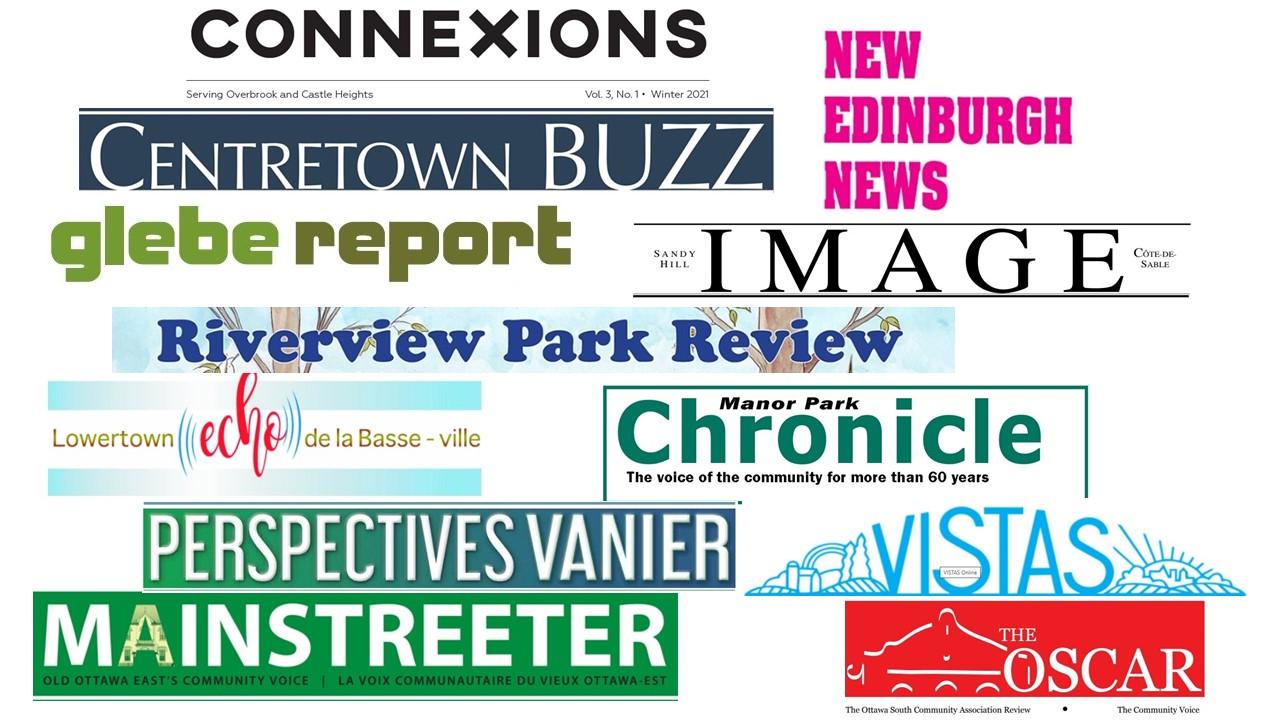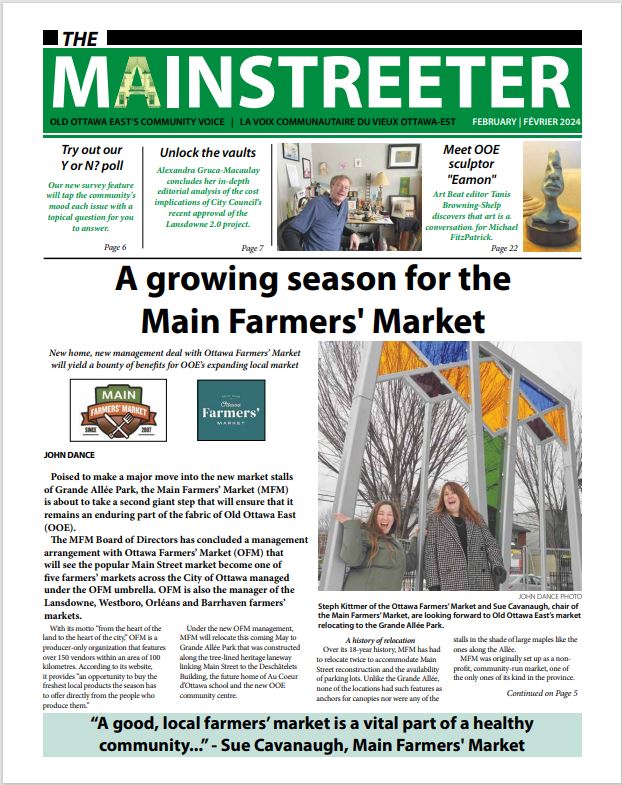John Dance
Despite the pandemic, climate change, political divisiveness and social media focused on virtual communities and individuals, local physical communities continue to thrive through their newspapers. The Mainstreeter is just one of the non-profits that regularly entertains and enlightens residents.
Over the last two decades, mainstream commercial media have reduced local coverage or simply gone out of business in the face of Google and Facebook gobbling up advertising dollars. While The Ottawa Citizen/Sun and several television and radio stations still have several reporters who focus on local matters, they tend to deal with broad city or regional issues. Meanwhile, what happens in, say, Old Ottawa East doesn’t get reported on except in The Mainstreeter. Readers get to see pictures of their kids’ winning hockey team, something that doesn’t happen with the city’s daily newspapers.To get a sense for the state of nine nearby community papers, The Mainstreeter canvassed their editors, seeking information on their papers’ histories, status, operations, and challenges.
What emerged was a picture of vibrant community-based and business-supported enterprises produced with the talent and energy of about 1200 volunteers and with direction from editors and a few others occasionally rewarded with limited honoraria. What follows is a summary of what their editors shared.
The papers covered by this survey were: the Glebe Report; the <strong>Centretown BUZZ; Alta Vista’s VISTAS, Old Ottawa South’s The OSCAR, the New Edinburgh News (NEN), Lower Town Echo de la Basse- Ville, the Manor Park Chronicle, Sandy Hill’s IMAGE, Overbrook’s ConneXions, Perpectives Vanier,Riverview Park Review, and The Mainstreeter. These papers cover the urban core and the next communities beyond.
History
The oldest local community paper is the Manor Park Chronicle, now 70 years old. The youngest is ConneXions. The OSCAR, NEN, The Glebe Report, IMAGE and VISTAS are almost 50 years old. The Mainstreeter, The Buzz, Riverview Park Review, Perspectives Vanier, and the Lower Town Echo are younger at 36, 26, 26, 19 and 10, respectively.
The origins of the papers vary but some are quite distinct. For instance, says editor Christina Leadlay, “The New Edinburgh News began in 1976 when the community was fighting the so-called Vanier Extension … New Edinburgh won this battle, and the extension was never built. Since then, the NEN has continued to be the voice of the community.” One outcome of the 2003 City amalgamation was that the funding was provided for key Vanier institutions, including seed money for what would become Perspectives Vanier.
All of the papers have evolved with changing technology and have become longer and more readable – and they tend to have readily accessible electronic versions. The Echo, which was the predecessor of The Mainstreeter, had just four black and white pages when it hit the streets in 1981, while now The Mainstreeter often runs to 44 pages, with the majority of them in colour.
Many papers are independent of community associations, however, The OSCAR, The Buzz and NEN are owned or operated by the related community association. Nevertheless, all papers have fiercely independent editorial policies.
Circulation and Financing
The combined circulation of the 12 papers is about 73,000, a sizable number in light of what The Citizen’s circulation may now be (data are not readily available). In 2015, The Citizen had a circulation of about 93,000 but it undoubtedly has declined since then.
Two fundamental differences between the remaining mainstream newspapers and non-profit community papers are: the former charges readers an ever-increasing amount and, generally, publishes six times a week while the community papers are free of charge and publish between five and 11 times a year. About half of the community papers publish 10 to 11 times/year. The others publish just four to six times.
Both for-profit and non-profit papers depend on paid advertising. The former are also now receiving some support through a new federal $595 million program, but community papers have historically received little government support aside from some political advertising.
Content
“News with a local angle,” is how NEN describes the content in their newspaper. And this is common to all of the community papers. All of them have regular columns from such parties as community associations and activities groups, schools, churches and elected officials.
Community association columns and articles deal with their range of efforts including transportation, development, public safety, environment, trees, heritage and housing.
Perspectives Vanier has a unique filter for its news: “We cover positive stories that happen in Vanier or happen to Vanier residents. If it has a cherry on the rooftop of the vehicle – we don’t cover it,” says Christian Marcoux, journalist-coordinator of Perspectives.
All of the community papers have regular reporting or columns on such matters as technology, indigenous issues, health matters, book and film reviews, food, disability issues, local sports, travel, and, in one case, “decluttering.” Arts and community events are also regularly reported. “There is something for everyone,” says the Echo’s editor John Chenier.
One common feature is regular reporting on business, often with profiles of new businesses. NEN’s “Burgh Business Briefs” section runs five-six pages every issue. The OSCAR’s “Business Beat,” is a prominent standard feature that reports on new businesses and changes with other businesses.
”We have some exceptional contributors of various types of articles and there are approximately 20 plus regular columnists,” says Carole Moult, editor of the Riverview Park Review. “Some columnists pay for an ad if they are supporting their business. Probably the most well-read column of the RPR is the Planning and Development column for the Riverview Park Community Association by Kris Nanda.”
Some papers have particularly unique features. For instance, the Glebe Report’s back cover alternates between “a striking photo and a piece of art by a local artist,” says Editor Liz McKeen. NEN has its “Breezy Bits” on the back page with its “little announcements like birthdays, weddings, anniversaries, condolences, welcomes and farewells, and other happy little announcements to share with neighbours.” ConneXions profiles interesting people through features called “Humans of Overbrook.” In The Mainstreeter, unusual, diverse and fun activities in and around Old Ottawa East are often featured on its “Eclectic Events” page.
“We try to balance the challenges that our readers must respond to with successes and upbeat stories,” notes BUZZ editor Alayne McGregor. “It’s always an interesting challenge to find enough relevant photos.”
Most of the papers welcome letters to the editor and op-eds. Most editors include their own editorial on relevant matters. “[W]e print what comes in (after checking and editing) so it depends on the energy level of community activists and writer,” says IMAGE’s Jane Waterston. “We follow the community association but if there is nothing interesting going on we don’t print anything. Anyone who lives or works in the neighbourhood is welcome to submit.”
The Monthly (or Bimonthly) Task
The volunteer-based operations gear up for each issue with core teams and the volunteer writers, photographers and artists who produce an avalanche – or trickle – of copy that may or may not meet the deadline. The core team, usually including the editor, copy editors, the advertising manager, and a lay-out expert, then make order and, occasionally, beauty out of the deluge.
The single largest expense – one that has recently grown much faster than the rate of inflation – is the cost of printing the newspaper, including the mounting costs of ink and paper. Once the paper is printed the copies are generally distributed to volunteers who deliver to specific streets or multi-unit buildings. This vital volunteer role makes it possible for the papers to be distributed throughout the communities free of charge. In a few instances, papers contract with Canada Post or others to deliver the copies to large multi-unit buildings, but this is costly.
To augment distribution, several papers have bought newspaper boxes so that passers-by may readily get a paper. Given that their readerships overlap, the Glebe Report and The OSCAR share boxes. Like those two newspapers, The Mainstreeter had its five newsboxes painted by local artists who incorporated local landmarks into their designs.
Challenges
Aside from the relentless need to get advertising to keep going, community papers face a raft of issues beyond just the production of each issue.
In terms of news, with their infrequent publication, community newspapers face the challenge of being timely, relevant and actually “news.” But given that many of their stories aren’t reported elsewhere, they often provide readers with information they haven’t seen elsewhere or, at least, provide a level of local details that wouldn’t otherwise be available.
“Reliance on volunteers has its upside, but means the product is not always at the peak of professionalism,” says McKeen. “Sometimes [it is] hard to find writers to cover stories. [You] need to walk a fine line between saccharine boosterism and hard-hitting gotcha journalism (an exaggeration but hopefully you get what I mean — community building vs writing hard truths about, for example, neighbourhood conflicts).”
“Tackling issues with journalistic rigour, when the vast amount of our contributors are from volunteers with (quite understandably) no professional writing experience, is also a challenge,” notes Wes Smiderle, Manor Park Chronicle editor.
The constant turnover of volunteers is always a challenge too. Similarly, filling key positions, especially the editor, advertising, financial, distribution and social media managers, is critical for the operation of the paper.
“We include both hard news and features, and both more detailed-oriented planning stories and profiles of people important to the area,” says McGregor. “We try to balance the challenges that our readers must respond to with successes and upbeat stories. It’s always an interesting challenge to find enough relevant photos.”
For Lorne Abugov, who edits The Mainstreeter, “the biggest challenge is to produce a newspaper that all of our readers find engaging, that tries to find the sweet spot or the right mix of news and features. When I took on this role, I worried whether a small community like ours could generate enough interesting stories. I now know there is no shortage of great stories in our community – they’re out there just waiting to be uncovered.”
One pet peeve of volunteers is the difficulty of getting information from the City of Ottawa. While the City provides staff for interviews with mainstream media, often community papers get only limited email responses from the City’s media relations group. “The City, our city, should be less guarded and closed about information,” says Brendan McCoy, The OSCAR editor. “Getting information or anything from the City of Ottawa is a challenge,” says Marcoux. “We can never get e-mails from City employees directly. It goes through communications and that rarely meets our deadlines. We have missed many stories over the years because of City of Ottawa practices. We still find a way mind you.”
All community papers face the challenge of how to distribute the paper to closed apartment and condominium dwellers. And there is the broader and related issue cited by the Echo’s John Chenier: “The disintegration of community, started by the dissection of neighbourhoods by major transportation arteries, is now further being exacerbated by more highrise buildings whose residents are transitory — Lowertown is somewhere where you might live three to five years of your life— and live insulated from the community and their neighbours.”
“[P]eople in the high density housing may/may not be allowed to even receive our publication-or even feel connected to the community while those in single family dwellings may feel quite connected,” says Moult. “Then, do we even drop off the community paper at some locations? With some yes, others no. In Old Ottawa South, the Glebe or Manor Park the community paper will be created for a fairly homogeneous group of readers.”
“Maintaining a healthy advertising base,” is also a key challenge, Leadlay notes. This became even more challenging during the pandemic when businesses closed and those that remained open often were stretched in many ways.
The pandemic also resulted in a few papers producing just an electronic version but this wasn’t satisfactory to the editors that their readerships. “We believe in paper,” says Marcoux. “We tried an electronic version back in the early days of COVID-19 and it just wasn’t the same.”
One troubling trend that RPR faces is that “Corporate businesses are generally not allowed to advertise and there are many businesses in Riverview Park owned by corporations,” says Moult. “Even some businesses who could previously advertise can no longer do so. The managers may want to [but] now not allowed. Or, there are businesses where there is no allegiance to the community where they are located. We did have a number of restaurants advertising, pre-pandemic. Today that is a problem. Fortunately, we have a good number of dedicated independent businesses who advertise.”
The pandemic threw a number of other challenges to community papers. In a few cases papers were not produced or distributed, particularly to businesses within the various communities that were mostly closed to the public. In all cases, there were fewer events to cover. On the other hand, the pandemic itself became a dominant story.
“Looking back, it has been a pretty happy era for the paper with people having more time on their hands, so we have a few new writers,” says Waterston. “And we have done some good work.”
The Future?
Despite these challenges and given the success of community papers over the last few decades, their future looks secure, at least relative to the commercial print media.
As VISTAS’ editor Karen Johns notes: “In VISTAS’ four-plus decades, it has made a recognized place in the community. The VISTAS board of directors is confident that its newspaper is growing in popularity and readership and believes that the future for it is bright.”
“The BUZZ sees community newspapers as increasingly important as the space for news and community concerns in the dailies and on radio and TV continues to shrink,” says McGregor. “More money, more ads, and more volunteers would help keep the paper vital.”
“I see no loss of interest in them [community papers] — the readers want them, and they can help local businesses,” comments Waterston. “If it is sustained by a volunteer base, it will continue. The important thing is to encourage good writers and be welcoming to all who show an interest. We are not hampered by bureaucracy, have no assets and nothing to lose. If things go wrong, we will just cease publishing.”
Although all of the community papers operate entirely independently of each other, there may be opportunities for collaboration and sharing of efforts. For instance, a case could be made that greater government advertising in community papers would be beneficial in many ways. Similarly, a united front to seek greater government responsiveness in dealing with requests for information could be worthwhile. There is a provincial association of community newspapers based in Toronto, however, membership is restricted to for-profit papers, thus excluding most of Ottawa’s community newspapers.
While an organization comprised of local non-profit newspapers could be “hugely beneficial” to their operations, according to The Mainstreeter’s Lorne Abugov, he and other editors readily acknowledge that they are already stretched, so that another effort and more meetings would be a challenge.
American political scientist Robert Putnam has argued that the decline of newspapers contributes to the erosion of “social capital” and of democracy. In Ottawa, at least, the strength of our local non-profit community newspapers may contribute to building social capital and may strengthen local democracy. Perhaps our community papers are really important.
Wanted: Volunteers!
Volunteers are the lifeblood of community newspapers, and each of the nine papers that responded to The Mainstreeter’s survey rely on the various contributions of community members without whom these papers could not exist.
The vital roles that community newspaper volunteers play vary from newspaper to newspaper, but generally include writing, photography or illustration, copyediting, translation, distribution or a seat on the board of directors.
Some of the benefits associated with volunteering with your local newspaper include learning more about your community, mastering new skills or re-discovering old ones, meeting interesting new people, being a member of a productive team and learning to love deadlines.
If you would like to learn more about volunteering with your community newspaper, send an email to the paper at:
Alta Vista’s VISTAS: Editor@vistas-news.ca
Centretown Buzz: editor@centretownbuzz.com
ConneXions: editor@overbrook.ca
Glebe Report: editor@glebereport.ca
Image Sandy Hill: editor@imagesandyhill.org
Lower Town Echo de la Basse-Ville: volunteer.for.echo@gmail.com
Manor Park Chronicle: editor@manorparkchronicle.com
New Edinburgh News: newednews@hotmail.com
Perspectives Vanier: info@perspectivesvanier.com
Riverview Park Review: editor.riverviewrpr@gmail.com
The Mainstreeter: editor@mainstreeter.ca
The OSCAR: oscar@oldottawasouth.ca







